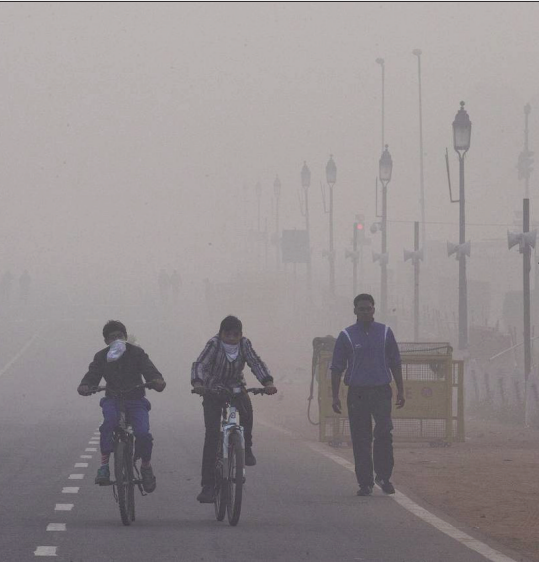
There was a time when driving to the office in the morning one would see hundreds of cyclists making their way to work with their tiffins dangling from the cycle bars. They were quite a menace and if you hit one, God help you! But have you wondered where those cyclists have disappeared? The peddling two wheelers have been replaced by scootys and bikes, a bigger menace on the road these days. If one was in a small town, it was quite a sight to see thousands of cyclists taking over the roads on to way to work. No more.
Across the whole of India, the time around Diwali brings festive cheer but in the norther part of the country, specially Delhi, it also brings toxic air along with dense smog, thus engulfing the nation’s capital and endangering millions of its residents. The situation immediately needed a robust policy for fighting the environmental disaster that happens. And so happened the Odd-Even scheme for private vehicles. However, going by the data and the previous odd-even experiments, odd-even scheme may provide some relief temporarily and definitely it is not the ultimate solution yera after year. Much more is needed.
The Odd-even scheme hopes to decrease pollution by clamping down on transport emissions that the cars and bikes spew out in turn which polluting the air. But the question is till what extent this pollution is true. In Delhi itself, estimates of transport’s contribution to overall pollution have ranged from 18% to 39%, according to a review of pollution studies conducted by the Council on Energy, Environment and Water (CEEW).
The judgment of banning certain vehicles along with the command and control measure taken by the present Government has rather ushered in action that is inverse of what the Court wanted the citizens to do. The Supreme Court judgement was taken under the knowledge of reducing the pollution levels in the city by banning the purchase of high-end diesel cars and thus leading to reduced pollution levels. In reality, the Odd-Even Policy does the opposite. In theory the policy should have halved the traffic numbers, but a host of exemptions means many more than half the nearly nine million vehicles registered in the city can still take to the roads every day. Furthermore, such command and control policies tend to be marginally effective due to the inelastic nature of demand by the consumers. The road rationing formula of the Odd-Even policy did not impact the sale of four-wheelers during its implementation period in Delhi.
Driving restrictions are used in numerous cities around the world to reduce pollution and congestion. In an attempt to improve the air quality of Beijing, China implemented a temporary road space rationing. They imposed restrictions on private vehicles by allowing even and odd license plates to drive on alternate days with the violators having to cough up 200 yuan for breaking the rules. On the benefits side, we find that the restrictions significantly reduce particulate matter. As a result, the traffic volume was reduced by approximately 32% during the period. Along with imposing the OddEven policy in Beijing, other pollution relevant policies were imposed to complement the driving restrictions. These included bus fare reduction and subway line openings. The total utility derived by the people of Beijing amidst these restrictions was high due to an extensive and well connected public transportation system and expansion of its transit capacity. Beijing added subway capacity during the time when it imposed the Odd-Even Policy, so as to compensate the impact of people’s substitution from auto to public transport.
Although CAC measures like the Odd-Even Policy was initiated and enacted in both Delhi and Beijing, their impact differed as they were implemented differently. Taking the case of Beijing, along with imposing the Odd-Even policy, other pollution relevant policies were imposed to complement the driving restrictions. These included bus fare reduction and subway line openings. Therefore, the general public were incentivized to use public transport. Furthermore, Beijing added subway capacity during the time when it imposed the OddEven Policy, so as to compensate the impact of people’s substitution from auto to public transport. On the other hand, when the Odd-Even Policy was implemented in Delhi, it was done so in the isolation of other such policy incentives that made public transportation a cheaper and a more economically convenient way to travel. Rather than making public transportation system reliable and attractive enough to encourage the car users to shift to public transport, surge pricing by cab aggregators like Ola and Uber, made transportation more costly than before. Furthermore, the capacity of the Delhi metro remained the same and the excessive commuters added to the strain of the limited public infrastructure. On the air quality front, the Delhi’s OddEven scheme has provided limited benefits. This can be attributed to the fact that the share of private cars is small in the production of PM2.5 levels in Delhi and consequently, only marginal reductions could be achieved through the Odd-Even scheme. In winters, the Odd-Even experiment led to a ~7% reduction in the 24-hour PM2.5 concentrations; however, in summers, when the pollution levels are relatively lower and the share of vehicular sources is lower too, the impact of the scheme is further reduced (The Energy and Resources Institute, 2016).
